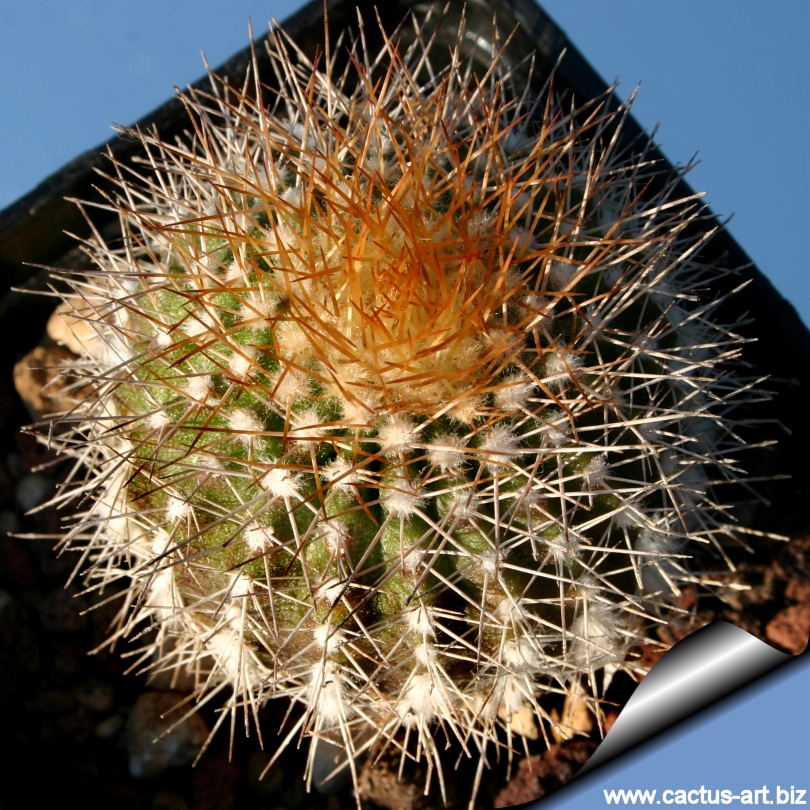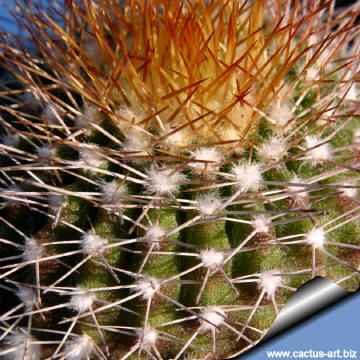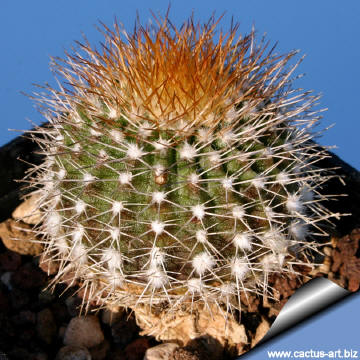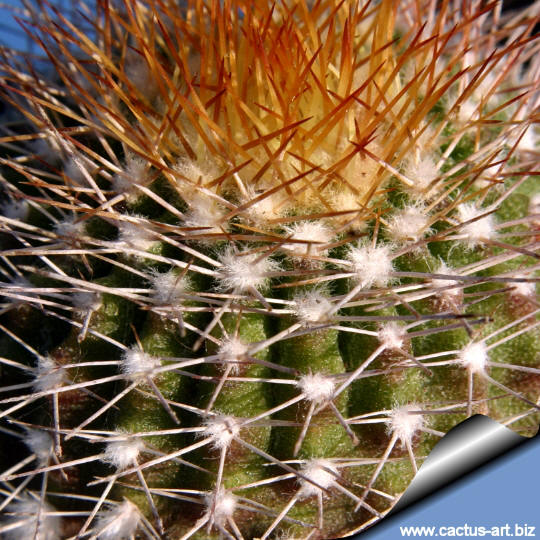|
|
|

Uebemannia pectinifera ssp. horrida HU1538 Montes
Claros, Minas Gerais, Brazil
This form is greener than the type with firm, almost lizard-skin
textured 'skin' and spines
more spreading and doesn't give
the comb-like effect of the type.
|
|
Description:
Uebelmannia pectinifera ssp. horrida is a solitary cactus 50-
100 cm tall.
Stem: Up to 18 cm wide, although usually globular or slightly
elongated in cultivation, it is reported to grow to as much as 100 cm
tall. It is greener than the type reddish-green to
brownish-green, with off-white scales. (In cultivation the colour of the
plants depends on sun exposure, the plants grown in shadow are green
with white stripes, while the ones in full sun take on a purple colour)
Ribs: 23 to 40, acute, vertical and prominent.
Areoles: Set closely and nearly confluent to form an almost
continuous grey to brownish felt-like line down the ribs' sides.
Central spines: Dark brown/grey, 1 to
4, up to 1.5(-2) cm long; the spines are close
set, neatly arranged,
straight, often interlacing, but are
Radial spines: Absent.
Flowers: Diurnal, funnel-shaped greenish yellow. They are 15 mm
long, 12 mm in diameter.
Blooming season: Flowers come sporadically from Early spring to
Late Summer.
Fruit: pear shaped to cylindrical violet-red 1,5-2,5 cm long.
Remarks: The Uebelmannia pectinifera ssp. horrida and all the
other plants belonging to the Uebelmannia pectinifera complex
are very variable in habitat,
it has three recognized
subspecies, but a
multitude of different forms exist, where each form is linked to others
by populations of plants with intermediate characteristics.
-
subsp. pectinifera:
It has about 18 ribs and slowly grow up to 50 cm in height. Origin: It
comes from the mountains in the higher part of the areal.
-
subsp.
flavispina: It has up to 29 ribs and can grow about 35 cm
tall. Origin: west of Diamantina.
-
subsp. horrida:
Stem with more than 23 ribs (up to 40) it is the taller of the three
and can reach 1 m of height. Origin: Serra do Espihašo.
|
 |
 |
|
Advertising
|
|
|
|
|
Family:
Cactaceae (Cactus
Family)
Scientific name: Uebelmannia pectinifera
ssp. horrida (P.J.Braun)
P.J.Braun & Esteves 1995
Origin: Brazil
(Mountains of Minas Gerais: Serra do Espihašo)
Habitat: The plants are found growing in
dry savanna and rocky areas in rock cracks or in pockets or small flat
areas of organic leaf mould and sand found among rocks at about 1000m
altitude. It is threatened by habitat loss. U. pectinifera
and its subspecies are more common in collections than they are in
habitat.
Conservation status: Listed in
CITES appendix 1.
Etymology: The species name "pectinifera" comes
from the Latin for "bearing combs". The subspecies name
comes from Latin "Horridus" meaning "sticking out,
rough, shaggy, prickly" for its more irregular and rough
appearance of spines than the type.
Synonyms:
- Uebelmannia
pectinifera var. horrida P.J.Braun 1984
|

|
|
|
|
Cultivation: This tropical
cactus loves warm moist, humid conditions and mist spraying is a must in
summer. Water regularly during the growing season and use a very
draining mineral potting substrate. At the onset of winter, do not
water. Uebelmannias need heat all year round and extra winter heat,
minimum 10C is best. Avoid any frost. Keep cool in summer. This plant
prove to be root prone if kept too cold in winter. To help stop this,
a good deep collar of pumice or lava grit is an excellent idea. It
prefers a position in full sun,
and possibly afternoon shade in summer. If you can place it so
that this occurs, the plant will be much happier.
Propagation: Seeds, but plants are often grafted,
making them easier to grow, particularly through the winter. If
possible using a rootstock that is more hardy than the Uebelmannia is
ideal.
Photo of conspecific taxa, varieties, forms and cultivars
of plants belonging
to the Uebelmannia pectinifera
complex
(This
Taxon has lots of synonyms ( like
many other cacti) with several controversial
varieties and subspecies, and comprises a
multitude of different forms, but where each form is linked to others by
populations of plants with intermediate characteristics):

 |
|